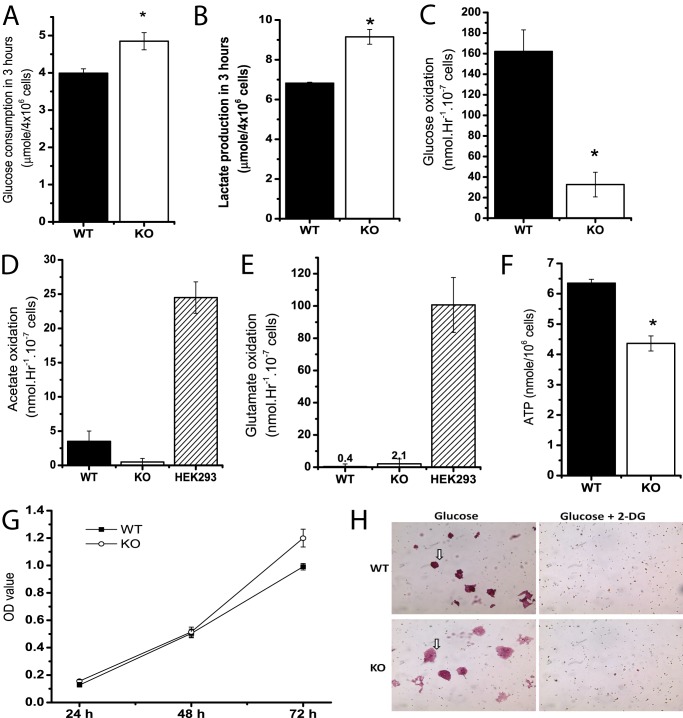FIGURE 1.
Undifferentiated Cited2Δ/− ESCs have an increased rate of aerobic glycolysis and reduced glucose oxidation. A and B, glucose consumption and lactate production in undifferentiated WT and Cited2Δ/− ESCs. 4 × 106 ESCs were resuspended in 2.0 ml of DMEM for 3 h and media were collected for determination of glucose consumption (A) and lactate production (B), n = 3. C–E, oxidation of glucose, acetate, and glutamate was measured in undifferentiated WT and Cited2Δ/− ESCs. Undifferentiated ESCs were resuspended in 2.0 ml of DMEM containing [U-14C]glucose (C), [2-14C]acetate (D), and [U-14C]glutamate (E), respectively. The 14CO2 release during 4 h of incubation was determined. HEK293 cells were used as a positive control for the oxidation of acetate and glutamate, n = 3–4. F, the ATP content of WT and Cited2Δ/− ESCs grown in complete ESC media was determined using a firefly luciferase-based assay and further normalized by the cell number, n = 4. G, proliferation of WT and Cited2Δ/− ESCs. 7,500 cells were seeded on gelatin-coated 96-well plates in 5 replicates and 20 μl of 3-(4,5-dimethylthiazol-2-yl)-5-(3-carboxymethoxyphenyl)-2-(4-sulfophenyl)-2H-tetrazolium (inner salt)/phenazine methosulfate solution was added to each well at the indicated time points. Absorbance at 490 nm was recorded and data from two independent experiments are presented. H, effect of 2-DG treatment on survival of undifferentiated WT and Cited2Δ/− ESCs. ESCs were seeded on 0.1% gelatin-coated 6-well plates with or without 2-DG. The starting concentration of glucose and 2-DG was 10 and 1 mm, respectively. 72 h later, cells were fixed with 1% paraformaldehyde and subjected to alkaline phosphatase staining. Note that WT and KO ESCs formed colonies with positive AP staining (in arrows) in glucose media and no ESC colonies survived by 2-DG treatment. *, p < 0.05 compared with WT controls.

